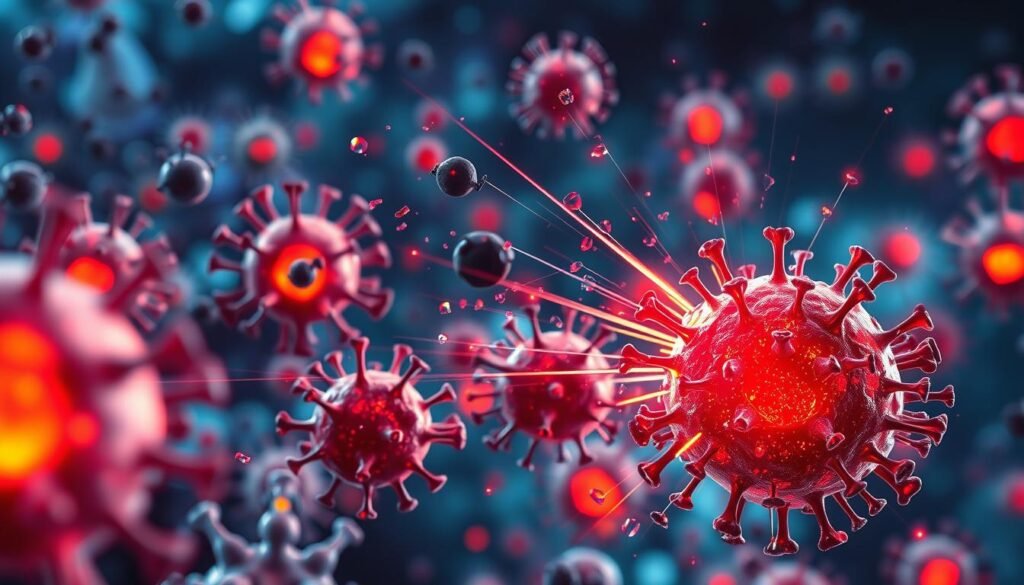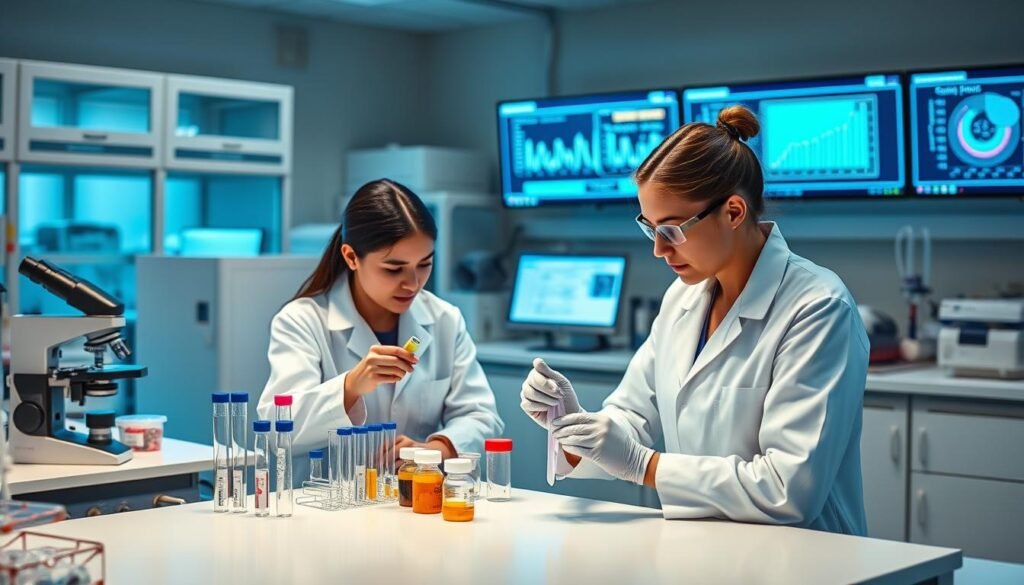Studies show a startling fact. People who stop smoking after finding out they have lung cancer do much better than those who don’t. Quitting smoking is crucial for patients battling non-small cell lung cancer (NSCLC). Currently, there are many ways to treat this cancer, based on how advanced it is and the patient’s health. Treatments like targeted therapy and immunotherapy are changing the game, offering hope for better survival chances.
Key Takeaways
- Non-small cell lung cancer treatment varies by stage and patient health.
- Smoking cessation can lead to better health outcomes post-diagnosis.
- Surgical options may suffice for early stages of NSCLC.
- Neoadjuvant treatments, including chemotherapy, are common for stage II NSCLC.
- Clinical trials are essential for developing and improving NSCLC therapies.
Understanding Non-Small Cell Lung Cancer
Non-small cell lung cancer (NSCLC) is the main type of lung cancer, with 85% of cases. It grows in lung tissue. Smoking is a big reason people get NSCLC. Yet, genes and the environment matter too.
Signs and symptoms of lung cancer have a few key signs. A lingering cough, feeling short of breath, and chest pain are common. Loss of appetite, weight loss, a hoarse voice, and breathing issues are also signs. Spotting these early can help with getting the right help quickly.
Doctors find NSCLC by using imaging tests and biopsies. This gives a clear look at the lungs and stages the cancer. Staging is key for choosing treatments. Catching cancer early helps a lot in fighting it. Later stages make treating it much harder.
Knowing the signs and symptoms can lead to catching the disease early. This means better chances for patients. In summary, getting to know NSCLC is crucial for good treatment and care.
Types of Non-Small Cell Lung Cancer
Non-small cell lung cancer (NSCLC) is the leading type of lung cancer, far more common than small cell lung cancer. It includes several types based on cell makeup. This detail is key for picking the right non-small cell lung cancer treatments.
The primary types of NSCLC are:
- Adenocarcinoma: Starts in mucous-secreting cells, mostly in the lung’s outer parts. It makes up about 40% of NSCLC cases.
- Squamous cell carcinoma: Comes from thin cells lining the airways, often related to smoking, and usually found in the lungs’ center. It’s about 30% of NSCLC cases.
- Large cell carcinoma: Made of larger, abnormal cells, this aggressive cancer can be found anywhere in the lung. It represents 10-15% of NSCLC cases.
There are other, less common types like adenosquamous carcinoma and sarcomatoid carcinoma. Knowing the exact type of lung cancer is essential. It helps create a treatment plan suited to the patient. The type of cell affects how the disease is treated and its outcome.
Figuring out the exact type of non-small cell lung cancer is crucial. Tests like CT scans and biopsies do just that. This info lets doctors tailor treatment plans. It helps them help patients more effectively, facing this tough disease.
Importance of Genetic Testing in Treatment
Genetic testing is key in creating non-small cell lung cancer treatment plans. It finds mutations like in the EGFR and ALK gene. Knowing these mutations helps doctors treat lung adenocarcinoma better.
About 15-20% of people with adenocarcinoma have EGFR mutations. Such mutations guide doctors towards targeted therapy. Specific mutations respond well to treatments targeting EGFR. Also, genetic testing helps avoid treatments that won’t work well.
Using genetic testing in lung cancer helps in finding the right treatment. It lets doctors make treatment plans that fit each patient’s genes. This improves treatment results. Liquid biopsies are now being studied to make genetic testing faster and more accurate.
Doctors use genetic testing results to pick the best treatment. Combining test results with targeted therapies and immunotherapies improves patient care. This approach makes lung cancer treatment better.
Non Small Cell Lung Cancer Treatment Options
The path of treating non-small cell lung cancer includes many options. These are surgery, chemotherapy, targeted therapy, and immunotherapy. The choice depends on the cancer’s stage, the person’s health, and possible side effects. Knowing about these options helps patients and families decide on their treatment.
Overview of Available Treatments
People with non-small cell lung cancer have a few main treatment paths:
- Surgery: This is usually for early cancers, trying to take out the tumor.
- Chemotherapy: This is for different stages and uses drugs to kill cancer cells.
- Targeted therapy: This looks at certain genes in cancer cells for a tailored treatment.
- Immunotherapy: This makes the body’s defense system fight the cancer, often in later stages.
Clinical trials might be an option, offering new treatments. You can find more about treatments at CDC’s lung cancer treatment resource.
Stage-Specific Treatment Approaches
Treatment for non-small cell lung cancer changes with the disease stage:
| Stage | Treatment Options |
|---|---|
| Stage I | Surgery is often enough; sometimes chemo is added after the surgery results. |
| Stage II | Surgery and chemo are used together to lessen the chance of the cancer coming back. |
| Stage III | Chemo and radiation are combined; targeted therapy may be used too, based on the cancer’s genes. |
| Stage IV | Care focuses on symptom relief. Options include chemo, immunotherapy, or targeted therapy, depending on the mutation. |
Choosing a treatment aims to improve life quality and increase survival time, especially for late-stage patients.

Targeted Therapy for Non-Small Cell Lung Cancer
Targeted therapy is a big step forward in treating non small cell lung cancer. It zeroes in on specific genetic mutations in cancer cells. Unlike traditional treatments that can hurt healthy cells, this method focuses only on the harmful ones. This makes treatment more effective and less harmful.
How Targeted Therapy Works
These therapies single out mutations like EGFR or ALK for treatment. They stop cancer from growing and have fewer bad side effects. This precision targets just the cancer cells.
Common Targeted Therapy Drugs
A few targeted therapy drugs have been approved by the FDA. They offer hope for those with NSCLC. Examples include:
- Osimertinib for EGFR mutations
- Crizotinib for ALK mutations
- Afatinib, for several tyrosine kinases
- Erlotinib, for some advanced NSCLC cases
These drugs have shown to help patients respond better and live longer. To know more about how targeted therapy works, research is always finding new treatments. This is good news for lung cancer treatment.
Immunotherapy as a Treatment Option
Immunotherapy is changing the way we fight non small cell lung cancer. It uses the body’s immune system, bringing hope to those in advanced stages. Drugs like pembrolizumab (Keytruda), nivolumab (Opdivo), and cemiplimab (Libtayo) are at the forefront. They target a key protein, PD-1, on immune cells to boost the body’s fight against tumors.
Other treatments, atezolizumab (Tecentriq) and durvalumab (Imfinzi), go after PD-L1 on tumor and immune cells. This triggers an attack on lung cancer cells. These PD-1/PD-L1 inhibitors can be given with chemotherapy or alone, depending on the test results and cancer stage.
Patients can get atezolizumab by injection every three weeks or through IV at different times. Sometimes, combining CTLA-4 inhibitors like ipilimumab (Yervoy) or tremelimumab (Imjudo) with a PD-1 inhibitor offers even more benefits for lung cancer patients.

Immunotherapy is powerful, but it’s not without side effects. Issues like fatigue, cough, and skin rash are common. More severe problems can happen, especially with CTLA-4 inhibitors, leading to autoimmune reactions. It’s crucial for patients to talk with their doctors about the risks and benefits.
The duration of immunotherapy treatments can affect survival rates. This makes it a key part of long-term cancer management.
For more details on non small cell lung cancer treatments, check out the latest research and therapies.
Chemotherapy and Radiation Therapy
Chemotherapy and radiation therapy are key in treating non-small cell lung cancer. They often work together to improve the chances of a good outcome. These therapies attack the tumor in different ways.
They can shrink the tumor, make symptoms better, and go after cancer cells that are left.
Combination of Chemotherapy and Radiation
Using chemotherapy and radiation therapy together is called chemoradiation. It makes treating non-small cell lung cancer more effective. Before surgery, chemotherapy can reduce tumor size. After surgery, it helps kill any cancer cells left.
If cancer can’t be operated on, chemotherapy may be the main treatment. When used with radiation, it aims to boost the treatment’s success. This approach also tries to protect healthy tissue around the cancer.
Side Effects of Treatments
Chemotherapy and radiation therapy are important but can cause side effects. Patients need to know what they might face. Radiation therapy may lead to tiredness, nausea, less hunger, skin changes, and lung issues.
Chemotherapy’s side effects include low blood counts, vomiting, diarrhea, tiredness, hair loss, and nerve damage. Other impacts are less hunger, mouth sores, skin issues, and constipation.
It’s vital to talk to your healthcare team about any side effects. Addressing them early is key to keeping a good life quality during treatment.
The Role of Clinical Trials in Treatment
Clinical trials play a key role in improving treatment for non-small cell lung cancer. They test new therapies to better patient outcomes. These therapies include targeted treatments, chemotherapy, radiation, and immunotherapy.
By joining a clinical trial, patients might access new treatments not yet widely available. Each trial follows a strict plan that outlines its goals and who can join. This ensures the new treatments are safe and effective.
Who can join a trial depends on factors like age, the cancer’s type and stage, and overall health. These factors help decide who might benefit most from the new treatments.
Trials take place in settings like hospitals and cancer centers. They usually go through four phases:
| Phase | Purpose | Participants |
|---|---|---|
| Phase 1 | Assess safety and dosage | 15-30 |
| Phase 2 | Evaluate effectiveness | Fewer than 100 |
| Phase 3 | Compare with standard treatments | 100 to several thousand |
| Phase 4 | Monitor long-term effects | Varies |
Patients are randomly assigned to different treatment groups to avoid bias. It’s important to know that lung cancer trials do not use placebos. This means participants always receive active treatment, not a dummy pill.

Palliative Care and Support Services
Palliative care is key in helping people with non-small cell lung cancer. It helps at all stages of their journey, focusing on managing pain and reducing stress. This improves their quality of life.
A team of specialists, including doctors, nurses, and therapists, provides necessary support. They work together to give each patient care that meets their specific needs. This approach helps manage symptoms effectively throughout treatment.
Introducing palliative care early is crucial. It leads to better health outcomes by addressing problems right away. Remember, palliative care is part of treating non-small cell lung cancer, not just for end-of-life care.
- Palliative care focuses on relieving:
- Pain
- Stress
- Other symptoms impacting daily life
- Services may include:
- Procedures for opening airways
- Pain management medications
- Emotional support and counseling
Patients should keep track of their symptoms. This way, they can discuss palliative care needs with healthcare providers. The care team offers various treatments to help.
| Treatment Type | Description |
|---|---|
| Palliative Chemotherapy | Relieves symptoms while addressing advanced lung cancer |
| Palliative Radiation | Targets tumors to reduce pain and discomfort |
| Thoracentesis | Drains fluid buildup in chest due to pleural effusion |
| Pleurodesis | Prevents fluid recurrence around the lungs |
| Stent Placement | Keeps airways open obstructed by tumors |
Conclusion
Beating non-small cell lung cancer (NSCLC) requires a detailed plan made just for you. This includes looking at the type of tumor, the stage of cancer, and how it reacts to treatment. It’s key to create a custom treatment plan to help patients live longer. Advances in specialized treatments and using the body’s immune system are making a big difference. They give hope when it seems hard to find.
The support of a knowledgeable healthcare team is vital. They guide patients through treatment options, like chemotherapy and radiation. This support greatly improves life quality for those with the illness. It’s a fact that many lung cancer patients may not live longer than a year after finding out they have the disease. This highlights the need for quick and effective treatments. For those who want to learn more, in-depth studies on lung cancer can be very helpful.
As science moves forward and treatments get better, our hope for beating this cancer grows. The dedication to helping patients from the start to the end of their journey shows true care. By staying updated and using every treatment available, the path to recovery gets easier. This leads to better health outcomes for everyone involved.